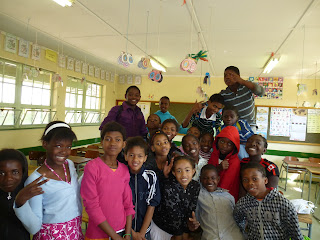So, sorry I've been so terrible at actually updating this. We've been so so busy! I'm gonna backtrack though, to a few weeks ago when we went to visit our permanent sites for the first time. I'll be going back to Tses for good this Friday, and then I'll be there for the whole 2 years!!!
The Tses welcome sign! Somewhere on Facebook, I also have
pictures of the sign with Barbara—the group 32 PCV I’ll be replacing. The
junior secondary school has had volunteers, either Peace Corps or World
Teach, for the last 10-15 years. The associated primary school/hostel also gets
2 German volunteers every year, who we usually end up befriending.
Upon my arrival in Tses on Saturday, I was intrigued to
find that it is both exactly like, and nothing like, my expectations. The part
of Tses that you might call the “downtown” (downvillage?) is something akin to
a town square, I guess? There’s a shop where you can buy the essentials but not
much more, two bars/clubs, a gas station, and a barbershop. Maybe a few other
things too, but you get the picture. Side note: at least one of the clubs, the
gas station, and the shop are owned by the same white South African woman.
Which is pretty weird considering that those probably see half of the business
done in the whole village. I saw two cars and three donkey carts while we were
there. There are maybe 50 houses in ‘town’; then there are 5 locations, or
separate shantytown-like neighborhoods on the outskirts of Tses.

The red-door structures are flush toilets that the village
council installed for every home in this location last year. I’m still trying
to find out who the sponsor was (we think it was someone from out of the
country). The juxtaposition of these permanent structures with tents or
corrugated metal shacks looks pretty silly, but the project was a huge deal in
terms of sanitation and definitely worth it!
Outside of even the locations, there are lots of farms.
Anywhere you go around Tses, there seem to be stray
goats/sheep/donkeys/cows/horses/chickens wandering around. Nobody here really
farms vegetables or grains, but there are definitely lots of animals!
In terms of the landscape, Tses is actually more diverse
than you might expect. The Fish River (above) flows about 20km out of the
village. Another few hundred km south, it turns into the Fish River Canyon,
which is comparable to the Grand Canyon in the US (and we’re definitely hoping
to hike it sometime while we’re in country)! There is also a big mountain
structure that may or may not be a volcano (nobody seems to know), hot springs,
and… well, lots and lots of desert.
There are a few sand dunes just to the south of Tses.
Apparently there’s something special about dune sand? Construction will start
on the Tses glass factory next year, and it’s expected to bring in about 8000
people eventually. Kind of a big deal when the population of Tses right now is
estimated to be under 2000.
My school, St. Therese, is a former mission school and is
still sort-of associated with the church next door. St. Therese is a lower
secondary school, so we teach grades 8-10. Most of the learners stay in the
hostel by the school (where I sort-of live, but in a separate building).
Learners may live at the hostel if their families live far out of town, or if
they qualify as OVCs—orphaned and vulnerable children. Nearly all of the
learners attending St. Therese are OVCs, which 1) is crazy to imagine! and 2)
means there is a definite lack of support from home/parents. But, it sounds
like that’s pretty much the case with all Namibian learners regardless…
Needless to say, I'm both excited and terrified to move back to Tses for the next 2 years. I'm very grateful that Barbara will be there to show me the ropes for the first month or so, and also that all of my colleagues speak English! (since it sounds like that's not the case in all of the schools.) I'll keep you updated!




